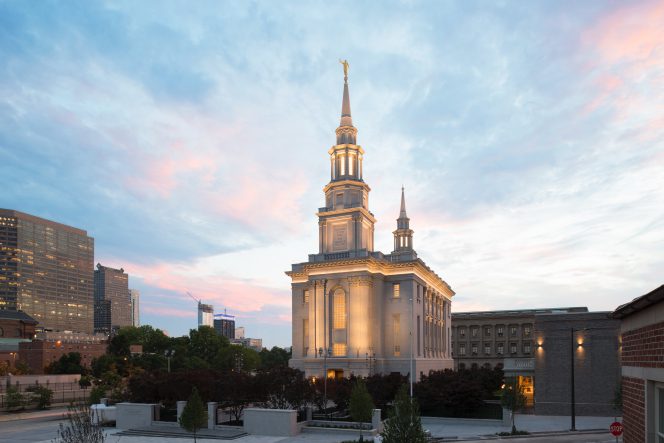
Not infrequently, I encounter the claim — often very derisively expressed — that Mormon doctrine is impossible to pin down. “It’s like trying to nail jello to a wall!” declare some critics, not very originally.
And it’s unquestionably true that Mormonism is, on the whole, creed-less. Our leaders aren’t theologians. We don’t have a whole host of academically-trained doctrinal experts, and we’ve certainly never had an authoritative, official council in which such theologians have met to hammer out precise, binding formulae regarding the interrelationships of the persons within the Trinity, the interface between divinity and humanity in Jesus of Nazareth, and other such issues.
But does that mean that Mormonism lacks any and all doctrinal clarity? In my view, not even remotely.
Late last night, just before turning off the lights, having encountered the claim of Mormon doctrinal confusion yet again, I doodled for a few minutes and came up with a list of fifty questions on which I think Latter-day Saint answers are pretty unambiguous:
- Does God exist?
- Is God pure spirit, or is God corporeal?
- Is God our Father?
- Does God have a Son?
- Is Jesus God’s Son?
- Is Jesus divine?
- Did Jesus atone for our sins?
- Is there an alternate path to heaven other than through Jesus?
- Did Jesus rise from the dead?
- Will Jesus return at the end of the world?
- Will Jesus judge the world?
- Does the Bible contain the word of God?
- Does the Book of Mormon contain the word of God?
- Is the Book of Mormon ancient?
- Was the Book of Mormon translated by the power of God?
- Did Jesus visit the Americas after his resurrection?
- Did Jesus ascend into heaven?
- Did Jesus organize a church?
- Did the church that Jesus organized apostasize?
- Has the Church of Jesus Christ been restored?
- Did the Father and the Son appear to Joseph Smith?
- Was the priesthood conferred upon Joseph Smith and certain others?
- Does the Church of Jesus Christ of Latter-day Saints hold unique divine authority?
- Is baptism required for salvation?
- Is vicarious work for the dead efficacious and divinely ordained?
- Must such work be performed in temples, by proxy?
- Are those damned who perish in infancy?
- Are those damned who fail to accept Jesus in mortality?
- Will we be physically resurrected from the dead?
- Pending resurrection, will our spirits sleep in unconsciousness?
- Did Jesus visit the world of spirits between his death and resurrection?
- Are we predestined to salvation or damnation?
- Can we become like God?
- Does the Doctrine and Covenants contain the word of God?
- Was Brigham Young the legitimate successor to Joseph Smith?
- Is there apostolic authority in the Church today?
- Did Jesus really exist?
- Are the Father, Son, and Holy Spirit one God in three persons as the classical creeds teach?
- Are we saved by grace alone, without regard for works?
- Is the Bible inerrant?
- Is the Book of Mormon inerrant?
- Has revelation come to an end?
- Do we have free will?
- Did we exist before we were born?
- Is celibacy preferable to marriage?
- Is a professional clergy necessary?
- Was Jesus the son of Joseph?
- Did life on Earth originate by chance, or by divine intention?
- Is participation in a church community important?
- Is partaking of “communion” important?
I could easily have gone on. And on. I compiled the list above as fast as I could type. But I drew the line at fifty because the hour was late and I wanted to go to sleep.
You may disagree with the Church’s answers to these questions. You may not like them. You may think, correctly, that there’s much more to be discussed with regard to each of them. But there’s no contesting the fact that official Church teachings answer every one. Unmistakably.
My point is that few if any communicant Latter-day Saints would be unsure as to how the Church would answer any of those fifty theologically-significant questions. (Not to mention many more.)
Our scriptures were given to us mostly in the form of stories. God didn’t give us a systematic theological treatise or a manual of doctrinal terms. He revealed neither a Summa Theologica nor a canonized Mormon Doctrine. Presumably he could have done so, but he chose not to do it.
Latter-day Saint teaching doesn’t aspire to be like a system of geometry, with propositions, theorems, and deductive proofs.
But that doesn’t mean that Mormonism is a doctrinal free-for-all, a total chaos in which all is confusion.
In some important and relevant ways, I think, Mormon doctrine is comparable not to the geometry of Euclid’s Elements but to the “system” of the common law, built up out of cases (stories, essentially) and thousands upon thousands of decisions and judicial opinions. Perhaps even better (though I or somebody else would need to think this carefully through), it might be compared to the “unwritten constitution” of Great Britain.
Neither British nor American law is a total chaos, a bewildering free-for-all where anything goes.
Our doctrine is learned by living and working in the Mormon community, which is partly constituted by classes but, even more, by stories — in the scriptures and elsewhere. It grows not merely out of theoria but also out of praxis.
(I keep vaguely thinking that the work of Michael Oakeshott, which I haven’t read in many years, might be relevant here.)











